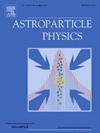宇宙射线介子通量在CJPL-II的测量
IF 2.9
3区 物理与天体物理
Q1 ASTRONOMY & ASTROPHYSICS
引用次数: 0
摘要
从2016年到2020年,我们利用塑料闪烁子望远镜系统测量了CJPL二期(CJPL- ii)的μ子通量,在1098天的有效寿命内检测到161个μ子事件。通过模拟地下μ子的能量和角度分布以及望远镜系统对地下μ子的响应,得到了探测效率。宇宙射线μ介子通量为(3.03±0.24 (stat)±0.18 (sys)) × 10−10 cm−2s−1,是世界地下实验室中最低的。本文章由计算机程序翻译,如有差异,请以英文原文为准。
Measurement of cosmic-ray muon flux at CJPL-II
In China Jinping Underground Laboratory (CJPL), the deepest and largest underground laboratory globally, the cosmic-ray muon flux is significantly reduced due to the substantial shielding provided by the overlying mountain. From 2016 to 2020, we measured the muon flux in the second phase of CJPL (CJPL-II) with a plastic scintillator muon telescope system, detecting 161 muon events over an effective live time of 1098 days. The detection efficiency was obtained by simulating the underground muon energy and angular distributions and the telescope system’s response to underground muons. The cosmic-ray muon flux is determined to be (3.03 ± 0.24 (stat) 0.18 (sys)) 10−10 cm−2s−1, which is the lowest among underground laboratories worldwide.
求助全文
通过发布文献求助,成功后即可免费获取论文全文。
去求助
来源期刊

Astroparticle Physics
地学天文-天文与天体物理
CiteScore
8.00
自引率
2.90%
发文量
41
审稿时长
79 days
期刊介绍:
Astroparticle Physics publishes experimental and theoretical research papers in the interacting fields of Cosmic Ray Physics, Astronomy and Astrophysics, Cosmology and Particle Physics focusing on new developments in the following areas: High-energy cosmic-ray physics and astrophysics; Particle cosmology; Particle astrophysics; Related astrophysics: supernova, AGN, cosmic abundances, dark matter etc.; Gravitational waves; High-energy, VHE and UHE gamma-ray astronomy; High- and low-energy neutrino astronomy; Instrumentation and detector developments related to the above-mentioned fields.
 求助内容:
求助内容: 应助结果提醒方式:
应助结果提醒方式:


